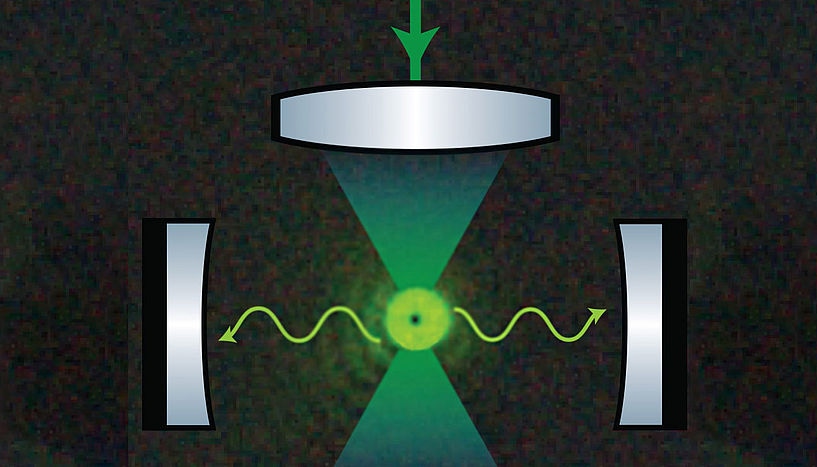Apr 1 2019
The laws of quantum physics begin to play an important role as soon as a particle is fully separated from its environment. To observe quantum effects, all thermal energy should be removed from the particle motion, that is, to cool it to absolute zero temperature as much as possible.
 A tightly focused laser field traps a nanoparticle between two highly reflecting mirrors, i.e. an optical cavity. Preferential scattering along this optical resonator allows to induce cooling of the nanoparticle motion in all three directions. (Image credit: Aspelmeyer group/University of Vienna)
A tightly focused laser field traps a nanoparticle between two highly reflecting mirrors, i.e. an optical cavity. Preferential scattering along this optical resonator allows to induce cooling of the nanoparticle motion in all three directions. (Image credit: Aspelmeyer group/University of Vienna)
Now, scientists at the University of Vienna, the Massachusetts Institute of Technology (MIT), and the Austrian Academy of Sciences, have demonstrated a novel technique for cooling levitated nanoparticles, bringing them one step closer to reach this objective. The team has reported their findings in the prominent journal, Physical Review Letters.
Very small objects, ranging from living cells to glass particles, can be trapped and controlled by tightly focused laser beams that can behave as optical “tweezers.” The development of this novel technique fetched a Nobel Prize in physics for Arthur Ashkin, in the previous year.
To date, while a majority of experiments have been performed in liquid or air, there is a growing interest for utilizing optical tweezers for trapping objects in ultra-high vacuum: isolated particles like that have unparalleled sensing performance and can even be applied for analyzing quantum phenomena involving huge masses, or crucial processes of nanoscopic heat engines.
Gaining complete control over the motion of particles—preferably in a regime where the laws of quantum physics control its behavior—is a major aspect in these study efforts. Earlier attempts to accomplish this tend to either immerse the particle into extra light fields between extremely reflecting mirror configurations, that is, optical cavities, or modulate the optical tweezer itself. Nevertheless, these methods were considerably limited because laser noise needed large laser intensities.
Our new cooling scheme is directly borrowed from the atomic physics community, where similar challenges for quantum control exist.
Uros Delic. Study Lead Author, University of Vienna.
Headed by Markus Aspelmeyer, the latest study has been reported in Physical Review Letters by investigators at the University of Vienna, the Massachusetts Institute of Technology (MIT), and the Austrian Academy of Sciences. The concept goes back to previous works performed by Innsbruck physicist Helmut Ritsch and also by US physicists Steve Chu and Vladan Vuletic, who found that it is enough to utilize the light that is directly scattered from the optical tweezer itself when the particle is maintained within an initially empty optical cavity.
Within an optical tweezer, a nanoparticle scatters a small part of the tweezer light in almost all directions. Upon placing the particle within an optical cavity, it becomes possible to store a part of the scattered light between its mirrors. Consequently, photons are favorably scattered inside the optical cavity. Yet, this can only be achieved with a light of certain colors, or to put it in other words, particular photon energies. If a tweezer light of a color, relating to a slightly smaller photon energy than needed is used, the nanoparticles will allow the photons to scatter inside the optical cavity by sacrificing some of their kinetic energy. This loss of kinetic energy efficiently cools its motion. While this technique has already been shown for atoms by Vladan Vuletic, the study’s coauthor, this is the first time where it has been applied to nanoparticles and used for cooling in all three directions of motion.
Our cooling method is much more powerful than all the previously demonstrated schemes. Without the constraints imposed by laser noise and laser power quantum behavior of levitated nanoparticles should be around the corner.
Uros Delic. Study Lead Author, University of Vienna.